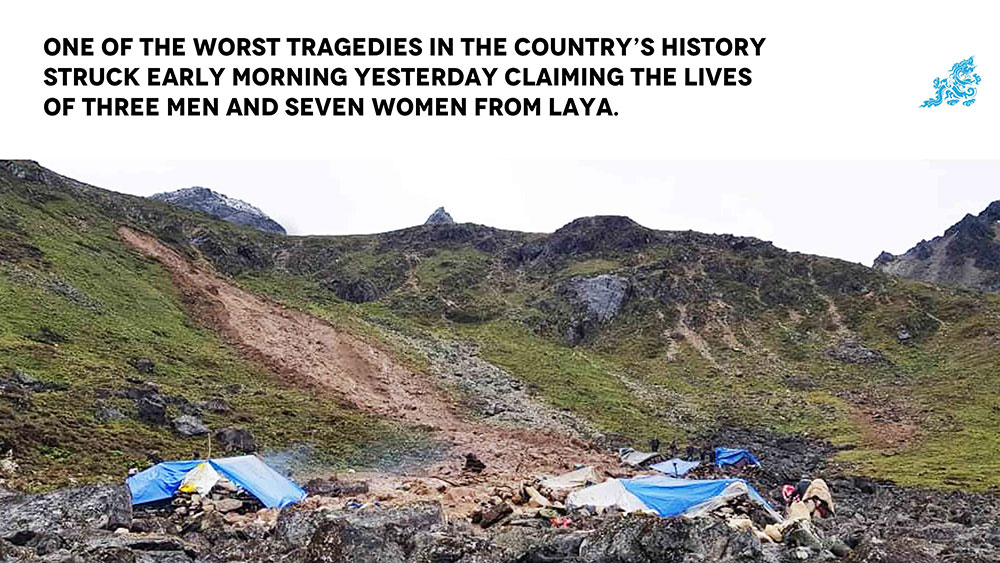Five other cordyceps collectors who were injured recovering at Thimphu hospital
In one of the worst tragedies in the country’s history, 10 highlanders from Laya died after the tents they were living in were swept away by a landslide near Tshari-Jathang, Ri-Druzhi in Laya, early morning yesterday.
The accident occurred at around 1am. The highlanders, three men and seven women, were out collecting cordyceps in the area since May 17. Seven of them were from Lungo village in Laya.
Five individuals who were injured at the site were airlifted using the two helicopters as soon as the accident was reported at around 3am. All the five, four men and a woman, are in stable condition and recovering at the national referral hospital in Thimphu.
According to doctors, besides a man who had suffered facial bone fracture and needed surgery, none suffered life-threatening injuries. The man also sustained a wrist fracture.
Another patient sustained multiple rib fractures including a chest injury. However, doctors said that the man was out of danger given the timely intervention made available.
“They were evacuated right on time and reached the hospital before their conditions worsened,” said a doctor at the emergency department. “It’d have been a different story if it wasn’t for the helicopter assistance because the nearest health facility is several hours from the accident site.”
By 11am, all the injured were airlifted to the national referral hospital.
A tragedy
At around 2am yesterday, Laya Gup, Lhakpa Tshering, woke up to a frantic knock on his door. The gewog’s mangmi had come with a grave news about cordyceps collectors near Tshari-Jathang.
The gup and mangmi started inquiring details of the accident from a villager, Phuba, who was among the 20 plus cordyceps collectors camped at Ri-Druzhi, which is located about a day’s walk from Laya.
According to the gup, there were about 18 tents pitched in the area out of which 12 were submerged under the slide.
“Phuba informed that 10 people were likely dead and five more injured at the site. He said that the injured would also die if the helicopters did not come to help,” he said, adding that the focus was then to call in the helicopters for rescue.
Calls to the Gasa dzongdag, disaster management focal person and health officials were made starting at 4am. The first chopper reportedly reached the site of the accident around 6:45am.
A team was formed to leave for Tshari-Jathang by 7am. “We arranged 10 horses and rations to go with them,” said that gup. At around 8:30am, a team of 19 individuals left from Laya Central School.
By noon yesterday, all contacts to the survivors and the team who left for the site ceased. The gup said that it could be because of the poor network and lack of battery in the phones of the cordeyceps collectors who had been in the field since mid May.
Every year, the cordyceps collectors in Gasa are screened for high blood pressure, diabetes and other diseases to ensure safety before they leave for collection in the mountains.
The collectors received their permits on May 17 this year. The collectors still have 10 days until their collection time expires.
It was leant that some of the groups who left for collection from Laya were returning home yesterday.
A Laya resident, who was also collecting cordyceps at a different location, said that they had family members in their group and they had returned to help the bereaved.
He said that every year, around five groups went to different locations to collect cordyceps. It was learnt that cordyceps grow in abundance once every four years. “And in Laya, there would have been more cordyceps this year. So many people went for collection this time, thus the group had many people,” he added.
The groups who left for collection mostly consist of close family members. “There were couples in the group who have passed away leaving their young children behind. It was really sad when we heard the news and we couldn’t eat or focus on finding cordyceps. So we decided to return home,” said another resident.
Tshari-Jathang is among the furthest cordyceps collection sites located in Laya.
Rainfall
Sources said that the landslide yesterday morning was triggered by heavy and continuous rainfall in Laya for the past few days.
Data with the National Center for Hydrology and Meteorology (NCHM) recorded the highest rainfall of 23mm on June 14 for the month of June, a day prior to the accident. On June 15, the station in Gasa recorded 13.6mm of rainfall.
This time last year, between June 12 and June 16, the stations recorded rainfall measuring not more than 10mm.
Last year, the dzongkhag recorded the highest number of rainy days — 214 days.
By Phurpa Lhamo and Younten Tshedup
Edited by Tshering Palden


